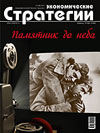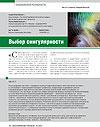Choosing Singularity
The article continues the cycle of works dedicated to the social system transition into a new qualitative state — from zoopopulation to psychosocial formation, where the moral-ethical characteristics of people will be the factor determining its further development and functioning. The authors postulate that “singularity” like a “vertical” on a well-known graph of the phase transitions distribution of A.D. Panov is attributable not only to biological and technical development of civilization — “technical singularity”, how it seems to ideologists of transhumanism, but namely to “moral singularity”. Moral and ethical properties, “worked out” by mankind in the course of historical process, have an even higher level of complexity than technical ones, therefore they are the leading factor in the further systemogenetic development of our space-time continuum. Aspiration of the transhumanism ideologists to represent singularity as a result of purely technical progress is an attempt to camouflage due to various information campaigns the destructive “concept”, which somehow manifests itself in the continuum of nonspecific activity results — in destruction of social structures and stagnation of social processes, in blocking the begun phase transition (moral singularity).
References:
- Nazaretyan A.P. Nelineynoe budushchee. Megaistoricheskie, sinergeticheskie i kul’turno-psikhologicheskie predposylki global’nogo prognozirovaiya [Nonlinear Future. Megahistorical, Synergetic and Cultural-Psychological Prerequisites of Global Forecasting]. Moscow, Institut vostokovedeniya RAN, 2013, pp. 303.
- Ot Bil’derberga k GULAGbergu: global’naya elita stroit elektronnyy kontslager’ [From Bilderberg to GULAGberg: Global Elite is Building an Electronic Concentration Camp]. Politikus.ru, 2015, June, 19, available at: http://politikus.ru/articles/52529-ot-bilderberga-k-gulagbergu-globalnaya-elita-stroitelektronnyy-konclager.html.
- Pervaya global’naya revolyutsiya. Doklad Rimskomu klubu [The First Global Revolution. Report to the Club of Rome]. Moscow, 1991.
- Sundiev I.Yu., Frolov A.B. Institutsional’noe raschelovechivanie kak metatekhnologiya sotsial’noy destruktsii [Institutional Dehumanization as a MetaTechnology of Social Destruction]. Ekonomicheskie strategii, 2016, no. 7.
- Mal’tsev S.A. Vse taynoe stanovitsya yavnym [Everything Secret Becomes Apparent], available at: http://samlib.ru/m/malxcew_s_a/
- Rokfelleru v shestoy raz peresadili serdtse v 100 let [Rockefeller for the Sixth Time had the Heart Transplanted When He was 100 Years Old]. Youtube.com, available at: https://www.youtube.com/watch?v=z8wAlhahNnQ.
- Sundiev I.Yu., Frolov A.B. Metarevolyutsiya 3.0: analiz sovremennosti cherez prizmu funktsional’nykh i patologicheskikh system [Meta-Revolution 3.0: Modernity Analysis Through the Prism of Functional and Pathological Systems]. Moscow, Institut ekonomicheskikh strategiy, 2014, 124 p.
- Sundiev I.Yu., Frolov A.B. K voprosu ob ekzogennykh faktorakh destruktsii sotsiuma v anizotropnom kontinuume [On the Exogenous Factors of Society Degradation in an Anisotropic Continuum]. Ekonomicheskie strategii, 2014, no. 6–7, pp. 153–169.
- Sundiev I.Yu., Frolov A.B Ekzogennoe vozdeystvie i razvitie anomal’nykh form sotsiuma v noveyshey istorii [Exogenous Impact and Anomalous Forms of Society Development in Modern History]. Ekonomicheskie strategii, 2014, no. 9, pp. 126–141.
- Frolov A.B. Metody otsenki sostoyaniya informatsionnoy sredy organizma cheloveka [Methods for Assessing the State of the Human Body’s Information Environment]. Moscow, GEOTAR-MED, 2002, 280 p.
- Bolotov Yu. Magi za oblakami [Mages Behind the Clouds]. Mir prognozov, available at: http://www.mirprognozov.ru/prognosis/society/magi-za-oblakami/ru.
- Umryukhin E.A., Sudakov K.V. Teoriya khaosa: preobrazuyushchaya rol’ funktsional’nykh system [Chaos Theory: Transformative Role of Functional Systems]. Rossiyskiy fiziologicheskiy zhurnal, 1997, no. 5–6, pp. 193–198.
- Sotsial’nye seti: modelirovanie vremennykh i kvantovo-podobnykh svoystv [Social Networks: Modeling Time and Quantum-Like Properties]. Novocherkassk: NOK, 2015.
- Oleskin A.V. Detsentralizovannye setevye struktury v ekonomicheskoy i politicheskoy sferakh [Decentralized Network Structures in Economic and Political Spheres]. Ekonomicheskie strategii, 2014, no. 9, pp. 98–107.
- Chto takoe frendzona i kak iz nee vybrat’sya. Nauchnyy podkhod [What does a Friend Zone Mean and How to Get Out of It. Scientific Approach]. PM, 2017, May, 30, available at: http://www.popmech.ru/science/366772-chto-takoe-frendzona-i-kak-iz-nee-vybratsya-nauchnyy-vzglyad/?utm_referrer=https%3A%2F%2Fzen.yandex.com.
- Shengal’ts I. Otlozhennaya Era Miloserdiya [Postponed Era of Mercy]. RUSSKAYaIDEYa, available at: http://politconservatism.ru/blogs/otlozhennayaera-miloserdiya.
- Sudakov K.V. Informatsionnyy fenomen zhiznedeyatel’nosti [Informational Phenomenon of Life Activity]. Moscow, 1999, p. 73.
- Shredinger E. Chto takoe zhizn’ s tochki zreniya fiziki? [What is Life in Terms of Physics?]. Moscow, RIMS, 2009, p. 73.
- Polezhaev E.F, Makushin V.G. i dr. Psikhologicheskie i fiziologicheskie osnovy truda [Psychological and Physiological Bases of Work]. Moscow, Profizdat, 1974, pp. 102–109.
- Savel’ev S.A. Upravlenie mozgom cheloveka [Management of Human Brain], available at: http://poznavatelnoe.tv/savelev_upravlenie_mozgom.
- Alekseenko A. Sergey Kapitsa: Istoriya desyati milliardov [Sergey Kapitsa: The History of Ten Billion]. Snob, 2012, June, 9, available at: https://snob.ru/magazine/entry/49621



